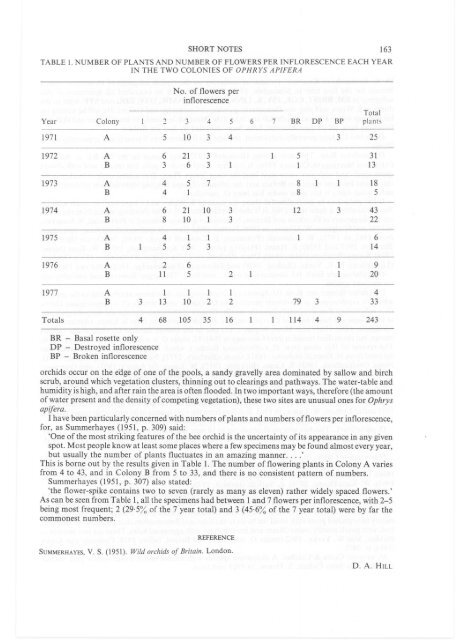You also want an ePaper? Increase the reach of your titles
YUMPU automatically turns print PDFs into web optimized ePapers that Google loves.
SHORT NOTES 163<br />
TABLE I. NU<strong>MB</strong>ER OF PLANTS AND NU<strong>MB</strong>ER OF FLOWERS PER INFLORESCENCE EACH YEAR<br />
IN THE TWO COLONIES OF OPHRYS A PlFERA<br />
No. of flowers per<br />
inflorescence<br />
Total<br />
Year Colony 2 3 4 5 6 7 BR DP BP plants<br />
1971 A 5 10 3 4 3 25<br />
1972 A 6 21 3 5 31<br />
B 3 6 3 1 13<br />
1973 A 4 5 7 8 18<br />
B 4 1 8 5<br />
1974 A 6 21 10 3 12 3 43<br />
B 8 10 1 3 22<br />
1975 A 4 1 1 6<br />
B 5 5 3 14<br />
1976 A 2 6 9<br />
B 11 5 2 20<br />
1977 A 1 1 1 1 4<br />
B 3 13 10 2 2 79 3 33<br />
Totals 4 68 105 35 16 114 4 9 243<br />
BR - Basal rosette only<br />
DP - Destroyed inflorescence<br />
BP - Broken inflorescence<br />
orchids occur on the edge of one of the pools, a sandy gravelly area dominated by sallow and birch<br />
scrub, around which vegetation clusters, thinning out to clearings and pathways. The water-table and<br />
humidity is high, and after rain the area is often flooded. In two important ways, therefore (the amount<br />
of water present and the density of competing vegetation), these two sites are unusual ones for Ophrys<br />
apifera.<br />
I have been particularly concerned with numbers of plants and numbers of flowers per inflorescence,<br />
for, as Summerhayes (1951, p. 309) said:<br />
'One of the most striking features of the bee orchid is the uncertainty of its appearance in any given<br />
spot. Most people know at least some places where a few specimens may be found almost every year,<br />
but usually the number of plants fluctuates in an amazing manner . . . . '<br />
This is borne out by the results given in Table I. The number of flowering plants in Colony A varies<br />
from 4 to 43, and in Colony B from 5 to 33, and there is no consistent pattern of numbers.<br />
Summerhayes (1951, p. 307) also stated:<br />
'the flower-spike contains two to seven (rarely as many as eleven) rather widely spaced flowers.'<br />
As can be seen from Table 1, all the specimens had between 1 and 7 flowers per inflorescence, with 2-5<br />
being most frequent; 2 (29,5% of the 7 year total) and 3 (45,6% of the 7 year total) were by far the<br />
commonest numbers.<br />
REFERENCE<br />
SUMMERHAYES, V. S. (1951). Wild orchids of Britain. London.<br />
D. A. HILL
















